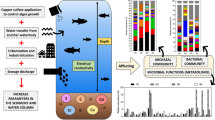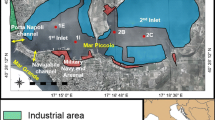Abstract
Striking differences were observed in the use of the electron acceptors involved in the degradation of organic matter by heterotrophic bacterial activity between a muddy and a sandy sediment on the same tidal flat of the Scheldt estuary. These bio-reduction reactions could have a quite different effect on the cycling of trace metals in the sediment as suggested by the results of the mobilization experiments. Trace metal speciation can be described as a function of the redox potential, in view of the fact that the latter is related to the heterotrophic bacterial activity.
Similar content being viewed by others
References
Baeyens W, Panultrakul S, Elskens M, Leermakers M, Navez J, and Monteny F, 1991. Geochemical processes in mud and sandy tidal flat sediments.Geo-Marine Letters 11:….
Balls PW, 1989. The partitioning of trace metals between dissolved and particulate phases in European coastal waters: A compilation of field data and comparison with laboratory studies.Netherlands Journal Sea Research 23:7–14.
Emerson S, Jacobs L, and Lebo B, 1983. The behavior of heavy metals in marine anoxic water: Solubilities at the oxygen-hydrogen sulfide interface. In: Wong CS, Boyle E, Bruland KW, and Burton JD (Eds.), Trace metals in sea water. NATO Conference Series, Plenum Press, New York. 579–608.
Francis AJ and Dodge C, 1988. Anaerobic microbial dissolution of transition and heavy metal oxides.Applied and Environmental Microbiology 54:1009–1014.
Higam D, Sadler P, and Seawen M, 1984. Cadmium-resistantPseudomonas putida synthesizes novel cadmium proteins.Science 225:1043–1046.
Jones J, Gardener S, and Simon B, 1984. Reduction of ferric iron by heterotrophic bacteria in lake sediments.Journal General Microbiology 130:45–51.
Lovley D and Phillips E, 1986. Organic matter mineralization with reduction of ferric iron in anaerobic sediments.Applied Environmental Microbiology 51:683–689.
Panutrakul S and Baeyens W, 1991. Behavior of heavy metals in a mud flat of the Scheldt Estuary, Belgium.Marine Pollution Bulletin 22:128–134.
Stanier R, Adelberg E, and Ingraham J, 1976. The methods of microbiology. In: Stanier R, Adelberg E, and Ingraham J (Eds.), General microbiology. Fourth edition. Macmillan Press LTD, London. 20–59.
Stookey L, 1970. Ferrozine. A new spectrophotometric reagent for iron.Analytical Chemistry 42:779–781.
Vanhooren H, 1989. Verspreiding van macrozoobenthos in de Westerschelde: Invloed van abiotische factoren en pollutie. Licentiaatsverhandeling, Rijksuniversiteit Gent. 100 pp.
Author information
Authors and Affiliations
Rights and permissions
About this article
Cite this article
Elskens, M., Leermakers, M., Panutrakul, S. et al. Microbial activity in sandy and muddy estuarine sediments. Geo-Marine Letters 11, 194–198 (1991). https://doi.org/10.1007/BF02431012
Issue Date:
DOI: https://doi.org/10.1007/BF02431012




